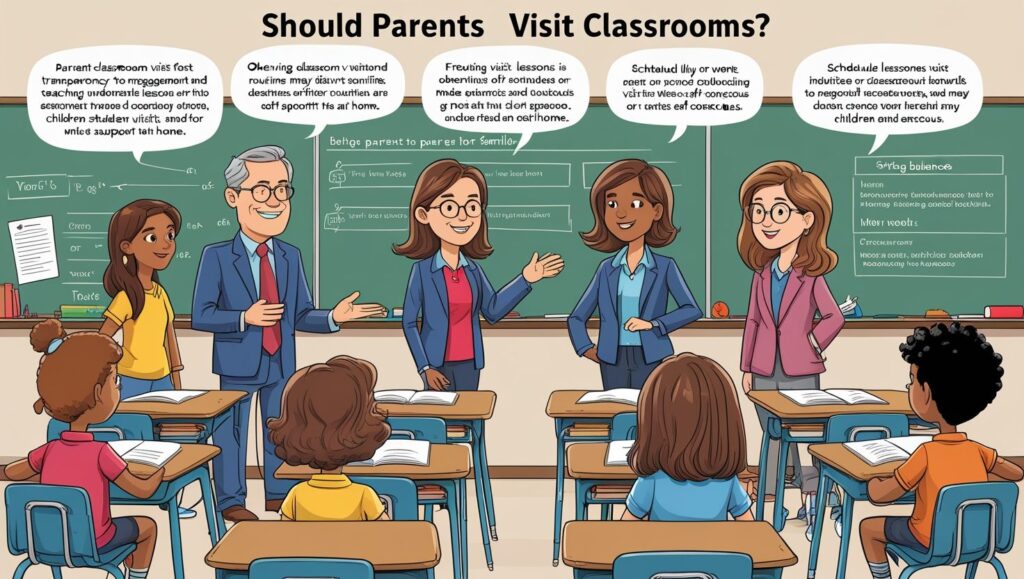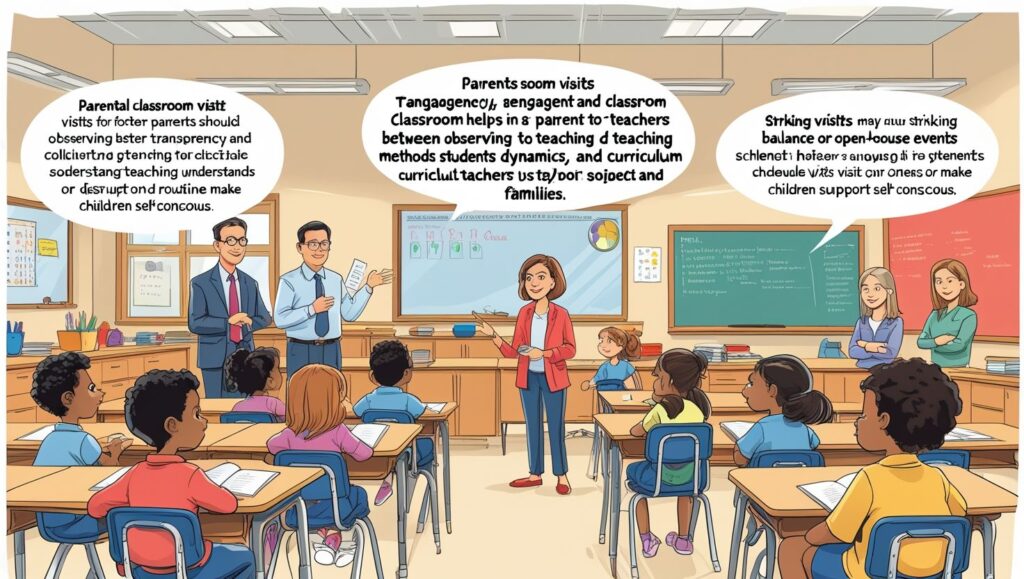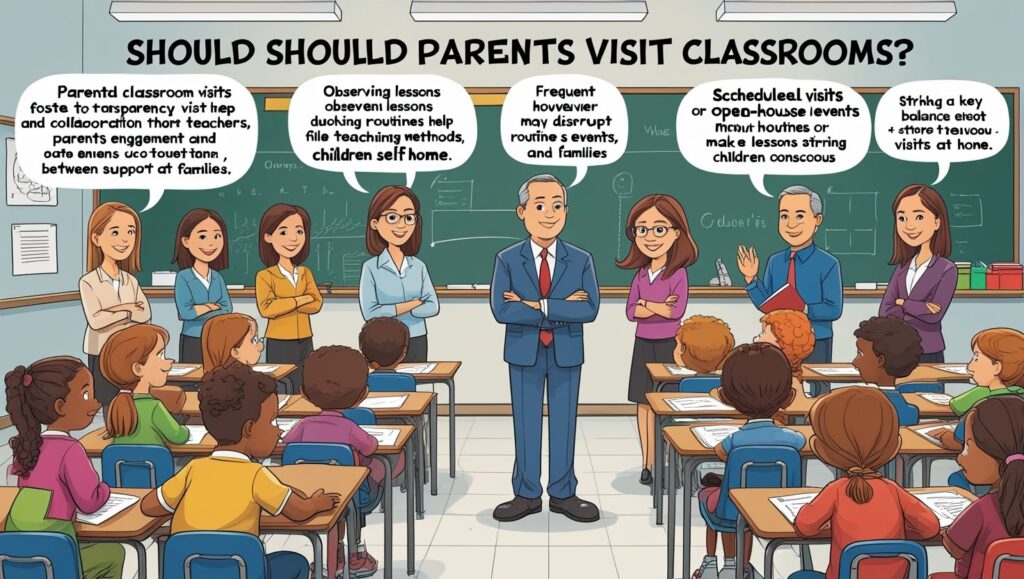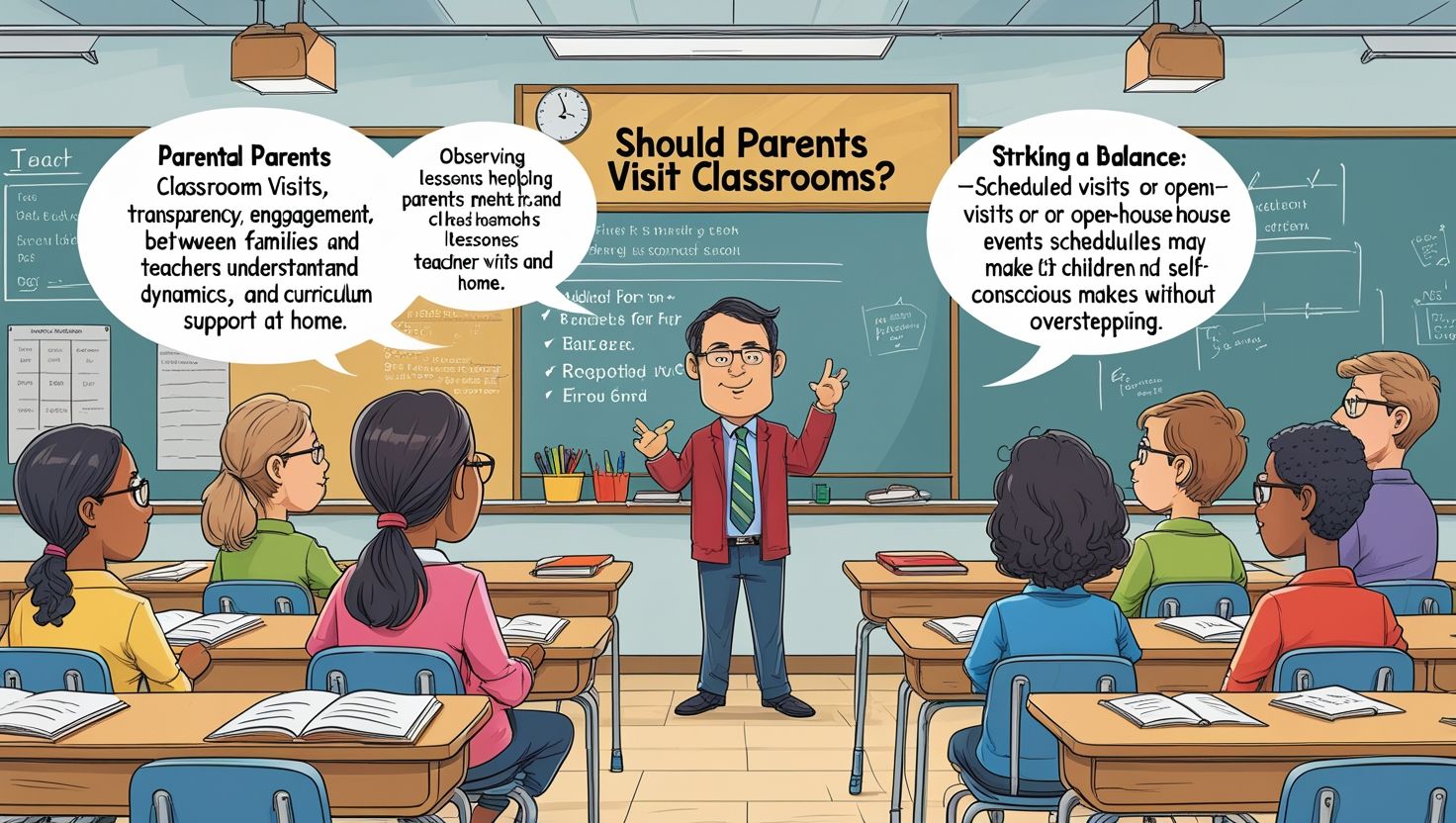Introduction:
“Should Parents Visit Classrooms?“, Parents play a vital role in their child’s education. Education is not limited to schools alone. Rather, it thrives on collaboration. When parents visit classrooms, they bridge the gap between home and school. This connection enhances learning. It allows both parties to understand the child better. As a result, children feel supported. They perform better academically and socially.
Furthermore, classroom visits provide insight. Parents can see teaching methods in action. They can observe student behavior and teacher engagement. Additionally, it allows parents to communicate directly with teachers. This ensures alignment in educational goals.
Despite its benefits, some question the need for such visits. Concerns about disruption and interference arise. However, with proper planning, these issues can be managed. Regular, structured visits build trust. They also foster a sense of community.
In conclusion, classroom visits help parents stay involved. They create a shared responsibility for student success. Therefore, the idea of parents visiting classrooms should be welcomed. It brings transparency, understanding, and growth in the educational process.
Building Home-School Connection
A strong home-school connection is crucial. When parents visit classrooms, this bond becomes stronger. Teachers and parents start working as a team. Moreover, children notice this cooperation. As a result, they develop more respect for both teachers and parents.
Visiting classrooms allows parents to understand school culture. It helps them learn about daily routines, teaching styles, and peer interaction. Consequently, they can better support their child at home. For example, parents might adjust homework help to align with school methods.
Furthermore, communication improves. Parents can ask questions directly. They can clarify expectations and express concerns. This avoids confusion and builds mutual respect.
However, these visits should be guided. Clear rules and schedules help avoid disruptions. Schools must prepare teachers and students in advance. Additionally, feedback after the visit promotes improvement. In summary, a home-school connection benefits all. With consistent visits, parents feel included. Teachers feel supported. Students, most importantly, gain confidence. They see education as a shared journey. Therefore, visiting classrooms plays a key role in connecting homes with schools.

Enhancing Parental Involvement in Learning
Parental involvement greatly impacts learning. When parents visit classrooms, they become active participants. This involvement shows children that learning is valued. As a result, students become more motivated. They pay attention. They try harder.
Additionally, parents learn new educational techniques. Many classroom methods today differ from past generations. Visiting helps parents stay updated. Consequently, they can better help with homework and projects. Also, these visits provide real-time feedback. Parents can see their child’s strengths and weaknesses. Therefore, they can offer support where needed. Teachers, too, benefit. They receive insights from parents. They can adjust teaching strategies accordingly.
Importantly, such involvement reduces misunderstandings. Parents become more empathetic. They realize the challenges teachers face. This leads to stronger support. Yet, involvement must be respectful. Parents should follow guidelines. They should avoid criticizing teachers during visits. Instead, they should ask questions and offer suggestions privately. To conclude, parental involvement boosts student achievement. Visiting classrooms is one effective way. It turns passive observers into active partners. Thus, schools should encourage it with structured opportunities.
Creating Transparency in School Operations
Transparency builds trust. When parents visit classrooms, they witness real teaching. They see how schools operate. This clarity removes doubts. It also reduces misinformation. Moreover, transparency creates accountability. Teachers become more aware of their responsibilities. They know that parents are observing. This leads to better preparation and discipline. However, it should not create pressure. Visits should aim to support, not judge.
In addition, classroom visits allow parents to see peer interactions. They notice how children behave in groups. They observe how discipline is maintained. These observations often correct misconceptions. Furthermore, when schools are transparent, parents feel valued. They believe the school has nothing to hide. This builds a stronger partnership. Consequently, complaints and conflicts reduce.
Still, visits must follow a system. Random visits may cause stress or distraction. Schools must schedule them properly. They must prepare staff and students. Guidelines should be shared beforehand. In conclusion, classroom visits promote transparency. They make school environments open and honest. When used wisely, such transparency leads to stronger relationships. Therefore, parent visits should be part of school policy.
Boosting Student Confidence and Performance
Children thrive on encouragement. When parents visit classrooms, students feel supported. This boosts their confidence. They try harder. They feel proud to show their parents what they can do. Also, knowing that parents care builds motivation. Students take their studies more seriously. They participate actively. They focus better. As a result, their academic performance improves.
Furthermore, some students feel anxious about school. Parental presence eases this anxiety. It gives comfort. It creates a sense of safety. Over time, it enhances emotional stability. Additionally, seeing parents interact positively with teachers is uplifting. It teaches respect. It builds trust in the school system.
However, not all students may enjoy classroom visits. Some may feel shy or pressured. Schools must address this. Visits should be designed to make students feel relaxed. Parents should encourage rather than criticize. In brief, classroom visits can uplift students. They enhance academic, emotional, and social well-being. For these reasons, schools should promote and normalize parental visits. When children feel supported, they perform at their best.

Strengthening Parent-Teacher Communication
Effective communication is key in education. Visiting classrooms helps parents and teachers communicate better. It moves the relationship beyond formal meetings. Instead, it becomes ongoing and meaningful. Through classroom visits, parents understand teaching styles. They see how content is delivered. As a result, discussions with teachers become more focused. There’s less confusion. Expectations become clearer.
Also, communication improves when it is two-sided. Teachers get to know the parents personally. This builds rapport. They can discuss the child’s progress in depth. Trust grows from shared observations. Furthermore, visits open the door for future dialogue. After the visit, parents often ask follow-up questions. They share feedback. They offer support. Teachers also feel encouraged to update parents more frequently.
Still, it’s important to respect time. Scheduled visits are better than surprise drop-ins. Schools should create a structure. This ensures smooth and productive interactions. In conclusion, parent-teacher communication is strengthened through classroom visits. It becomes open, clear, and productive. Strong communication supports student success. Thus, classroom visits should be part of the school’s communication plan.
Reducing Behavior Problems and Discipline Issues
Behavior problems affect learning. When parents visit classrooms, student behavior often improves. Children behave better when they know their parents are watching. It promotes discipline naturally. Moreover, students understand that home and school are connected. They realize both parents and teachers care. This reduces negative behavior. It builds responsibility.
Additionally, parents learn classroom rules. They see how discipline is maintained. Therefore, they can reinforce the same values at home. This consistency makes behavior management more effective. Furthermore, teachers gain insights from parents. For example, a student’s behavior may relate to home issues. Parents can explain. Together, they can find solutions.
However, visits should not embarrass children. They should not be used as punishment. The goal is support, not control. Schools must create a positive atmosphere. In summary, classroom visits help reduce discipline issues. They promote respectful behavior. They support a safe learning environment. Thus, involving parents in classroom settings can help improve student conduct significantly.
Encouraging Educational Accountability
Accountability ensures quality. When parents visit classrooms, they become aware of how teaching is done. This increases teacher accountability. It also encourages schools to maintain high standards. At the same time, students know their efforts are visible. This motivates them to take learning seriously. They become more responsible for their actions.
Also, parents become accountable too. They understand their role better. They see the importance of routines, homework, and attendance. Thus, everyone shares responsibility. Furthermore, visits promote honest feedback. If something is not working, parents can share their observations. This helps schools improve. Similarly, if things are working well, parents can appreciate efforts. Encouragement boosts morale.
Still, accountability must be constructive. Visits should not be judgmental. Instead, they should focus on improvement. Respect is key. In conclusion, classroom visits foster accountability for all. Teachers, students, and parents work together. This shared responsibility improves education outcomes. Therefore, schools should encourage visits as part of their accountability strategy.
Addressing Concerns and Misconceptions
Parents often have concerns about schools. Sometimes, these are based on rumors. Visiting classrooms clears doubts. It shows the real picture. For instance, parents may worry about discipline or teaching quality. A visit offers clarity. They see how things are managed. They can ask questions. They get answers directly from teachers. Furthermore, classroom visits reduce negative assumptions. Parents become more understanding. They see how hard teachers work. They also realize the challenges faced by students.
Additionally, visiting allows parents to express concerns calmly. Face-to-face talks are more effective than phone calls or emails. Teachers can explain. They can show examples. Still, visits must be guided by respect. Criticism should be polite. Schools should provide a feedback form. This helps in addressing issues constructively.
In short, classroom visits solve many doubts. They build understanding. They reduce tension between school and home. Therefore, schools should welcome them. It creates a more informed and supportive parent community.

Balancing Privacy and Participation
While parent visits are helpful, balance is important. Too many visits may disturb teaching. Teachers need space to manage classes. Students need time to focus. Therefore, visits should follow a schedule. Schools must plan dates in advance. They should limit the number of visitors. This avoids distractions.
At the same time, privacy must be respected. Some students may feel shy. Some may not want parents observing them. Teachers should explain the purpose of the visit. This creates a safe environment. Moreover, parents should follow rules. They should avoid taking photos or videos. They should not interrupt lessons. Participation is good—but it must be controlled.
Schools can also offer virtual visits. This is useful for busy parents. It allows them to join without being physically present. In conclusion, participation and privacy must go together. With planning, both can be maintained. Therefore, classroom visits must be designed carefully. When done right, they bring benefits without causing disruption.
Conclusion:
Classroom visits by parents are valuable. They create understanding. They promote teamwork. They improve student outcomes. Through visits, parents stay informed. Teachers feel supported. Students feel encouraged. Schools become more transparent and accountable. However, these visits must be structured. Respect for privacy and discipline is essential. Clear guidelines help maintain balance.
Despite challenges, the benefits are many. Better communication. Improved behavior. Higher achievement. Stronger trust. Therefore, schools should welcome parent involvement. They should include classroom visits as part of their strategy. Parents, too, must see these visits as opportunities—not inspections. Education is a shared journey. When parents join hands with schools, success follows. Thus, visiting classrooms is not only helpful—it is necessary. With the right approach, everyone wins.

private hacklink buyhacklink.com buyhacklink.com http://www.uskudarsukacagi.ipektesisat.com
Nurtepe Elektrikçi Efsane hizmet, ellerine sağlık. https://www.herturluicerik.com/yeni-nesil-sosyal-medya-clubhouse/
tıkanıklık ve Elektrikçi Saime M. – “Elektrik paneli modernizasyonunu yaptı. Artık hiç sıkıntımız yok.” https://www.bayburtpostasi.com.tr/rehber/uskudar-elektrikci
Sarıyer Elektrikçi Apartman yönetimiyle de iyi iletişim kurdu. https://www.dogrurehber.net/usta-elektrikci/
Güzeltepe Elektrikçi Yaşar T. – “İş yerimin elektrik bakımını yapıyor. Hiç problem yaşamıyoruz.” https://www.firmasec.com/firma/bbtmkc-usta-elektrikci/
Arnavutköy noktasal Elektrikçi Her işini özenle yaptı, gönül rahatlığıyla öneririm. https://www.firmaekle.net/elektrik-elektronik/istanbul/usta-elektrikci
İkitelli Elektrikçi Pakize Ş. – “Elektrik arızalarında ilk arayacağım kişi. Çok başarılı.” https://www.atakumademusta.com/index.php?journal_blog_post_id=1&route=journal3%2Fblog%2Fpost
majapahit4d
tn6nog
r6bbjk
ec7abq
vxj293
pt9hgi
Ataşehir su kaçağı tespiti Apartman bodrumundaki su kaçağı için birçok firma geldi ama bulamadı. Bu firma özel kameralarla sorunu hemen tespit etti. Murat Ö. https://social.sustpressclub.org/read-blog/17002
I appreciate how genuine your writing feels. Thanks for sharing.
Such a simple yet powerful message. Thanks for this.
Thank you for making this topic less intimidating.
Your tips are practical and easy to apply. Thanks a lot!
Excellent work! Looking forward to future posts.
Your passion for the topic really shines through.
Your writing style makes complex ideas so easy to digest.
I feel more confident tackling this now, thanks to you.
You’ve sparked my interest in this topic.
This content is gold. Thank you so much!
Your advice is exactly what I needed right now.
I hadn’t considered this angle before. It’s refreshing!
This was really well done. I can tell a lot of thought went into making it clear and user-friendly. Keep up the good work!
You explained it in such a relatable way. Well done!
Very useful tips! I’m excited to implement them soon.
This article came at the perfect time for me.
You really know how to connect with your readers.
Thanks for taking the time to break this down step-by-step.
Thanks for taking the time to break this down step-by-step.
Thank you for offering such practical guidance.
Your advice is exactly what I needed right now.
You have a real gift for explaining things.
I always look forward to your posts. Keep it coming!
This was a great reminder for me. Thanks for posting.
Very relevant and timely content. Appreciate you sharing this.
Thank you for making this topic less intimidating.
What a great resource. I’ll be referring back to this often.
kxq8zh
ava30l
5x9g3r
2tq796
I really like your writing style, superb information, appreciate it for posting :D. “God save me from my friends. I can protect myself from my enemies.” by Claude Louis Hector de Villars.